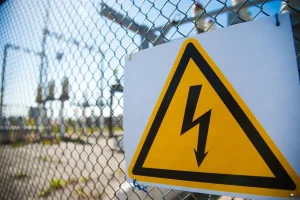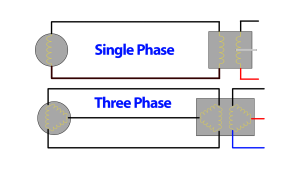Batteries, as common as they are in our daily lives, carry potential hazards that we often overlook. While they provide us with an essential source of power, improper handling or disposal of batteries can lead to a range of risks. As electricians, it’s crucial to understand these hazards and adhere to safety guidelines to mitigate them.

Chemical Hazards
Batteries consist of various chemicals to facilitate the generation of electric current. While these chemicals remain safely contained under normal use, if a battery suffers any damage or improperly disposed of, these substances may leak out.
Exposure to the chemicals found in batteries, like lead, cadmium, lithium, or acid, can lead to skin irritation, eye damage. If ingested or inhaled, it can cause severe internal bodily harm. Therefore, handling a leaking battery should be done with caution. Use gloves and eye protection, and the area should be properly cleaned afterwards.
Fire and Explosion Hazards
Batteries store energy, and mishandling or misusing them can result in the sudden release of this energy. Which can lead to fires or even explosions. This risk is especially significant with lithium-ion batteries, commonly found in laptops and smartphones. Overcharging, puncturing, or exposing these batteries to high temperatures can cause thermal runaway. This is a chain reaction leading to a fire or explosion. To mitigate this risk, always use the correct charger for rechargeable batteries, avoid exposing batteries to high temperatures or direct sunlight, and don’t keep them in confined spaces where heat can build up.
During charging and discharging, some types of batteries, such as lead-acid and nickel-cadmium, can emit hydrogen gas. In enclosed spaces like battery rooms in data centers, the accumulation of hydrogen gas can create an explosive atmosphere. It is critical to have effective ventilation systems in place that can prevent gas build-up and reduce the risk of explosion. Regularly checking and maintaining these ventilation systems, along with using gas detectors, can further enhance safety.

Electrical Hazards
When working with batteries in large-scale applications, such as Uninterruptible Power Supply (UPS) systems and data centers, there are significant electrical hazards that you must handle carefully to ensure safety. These systems often involve high-voltage and high-current battery setups that can pose serious risks if not handled correctly.
Shock and Electrocution
One of the primary risks in handling large battery systems is the potential for electric shock or electrocution. Batteries in UPS systems and data centers can operate at very high voltages, and even a single contact with a live component can result in a fatal electric shock. It is crucial for technicians to use insulated tools, wear appropriate personal protective equipment (PPE), such as rubber gloves and boots, and adhere to strict safety protocols to prevent direct contact with live electrical parts.
Short Circuits and Arc Flash
Short circuits can occur when conductive objects or liquids create an unintended path between two points of different electrical potentials within a battery system. This can lead to sudden, uncontrolled discharges of electricity, which in turn may cause arc flash incidents. Arc flashes produce intense heat, light, and pressure waves that can cause severe burns, blindness, and other injuries. Proper spacing and insulation of battery terminals and connectors, as well as regular maintenance to ensure that no conductive debris or liquids are present, are essential preventive measures.

Environmental Hazards
The environmental impact of batteries, particularly when improperly disposed of, poses significant challenges. Many batteries contain hazardous substances, including lead, cadmium, and mercury, which can leach into soil and water supplies if not handled correctly. This contamination can disrupt ecosystems, poison wildlife, and render water undrinkable. To mitigate these risks, recycling batteries is not just beneficial but essential. Recycling helps recover valuable materials and prevents hazardous substances from entering the environment. Many localities enforce stringent regulations regarding battery disposal, ensuring that they are processed safely. As electricians, we play a crucial role in promoting sustainable practices by informing clients about proper disposal methods and encouraging the use of designated recycling facilities. It’s vital to understand and leverage these recycling protocols to minimize environmental damage and support circular economy efforts in the battery industry.

Health Hazards
Beyond environmental issues, the chemicals found in batteries also present severe health risks. Exposure to heavy metals such as lead, which is often used in car batteries, can cause significant health problems. For instance, lead exposure can lead to neurological impairments, with children being particularly vulnerable to its effects, which include cognitive deficits and developmental delays. Cadmium, another toxic heavy metal found in some batteries, is known to cause kidney damage and other chronic conditions.
Battery electrolytes are often corrosive and can cause chemical burns upon contact with skin or eyes. In the event of a battery case rupture, which can occur if a battery is dropped or improperly handled, there is a risk of electrolyte leakage. Immediate clean-up procedures should be established, and appropriate neutralizing agents should be available to handle spills. Personnel should be trained in handling hazardous materials and equipped with PPE, including eye protection and chemical-resistant gloves.
Therefore, handling these materials with care is paramount. Precautions should include ensuring that used or damaged batteries are securely stored away from children and properly disposed of through certified recycling channels. Electricians should be well-informed about the potential health risks associated with battery exposure and equipped with the necessary knowledge and tools to handle emergencies, such as leaks or spills, safely and effectively.
Safety Guidelines
To ensure safe battery use and disposal, keep the following guidelines in mind:
- Always follow the manufacturer’s instructions for battery use, storage, and disposal.
- Do not attempt to recharge batteries that aren’t designed to be recharged.
- If a battery appears damaged or is leaking, handle it with gloves, keep it away from your eyes and skin, and dispose of it at a proper recycling facility.
- Store batteries in a cool, dry place and avoid exposing them to high temperatures or direct sunlight.
- Always recycle used batteries at designated recycling centers or drop-off points.
Drop Off Areas Around You
By simply dropping off your batteries, you can have a major impact on your environment and your community. Call2recycle is a great resource for finding local designated recycling centers near you. Many drop off centers are convenient. You can find them at your local grocery store, library, post offices, hardware stores and more. Check out their website and drop off your batteries today.

Conclusion
While batteries power our devices and make modern life more convenient, they come with potential hazards that we shouldn’t underestimate. As electricians, we must always prioritize safety, understand the risks, and follow best practices in battery use and disposal.
Our journey into the world of batteries has brought us from understanding what batteries are and how they work, through the different types of batteries and their uses, to the precautions we need to take to use them safely. As you continue your journey in the world of electricity, remember – knowledge isn’t just power, it’s safety, too.








